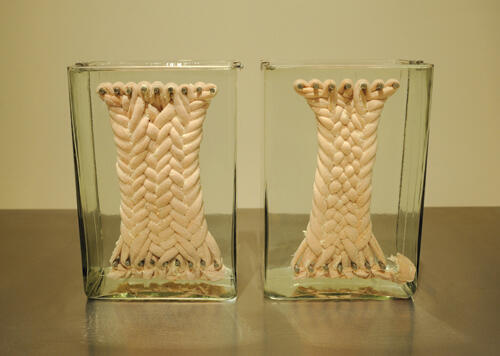Cristina Piffer
Malba - Costantini Foundation, Buenos Aires
For many years Cristina Piffer (Buenos Aires, 1953) has been weaving a weft that links the history of Argentina and certain organic elements, challenging dominant narrations and conveying visibility to characters these narratives have forgotten, counting losses of lives, anonymous or with names and surnames, denouncing diverse slaughters. The central devices of her objects and installations come from cattle. They are guts, stretched skins caught in metal hooks, meat cuts, dried blood, on cold counters of stainless steel (dissection tables of a morgue?) and acrylic boards, in elegant glass flasks which, together with acrylic framings, paraffin and formaldehyde, along with small texts, make up the list of articles that design this exciting and disturbing presences and suggest the abuse and the cruelty aimed at bodies and souls alike.

The selection of works of the period 1998-2011, carried out by curator Fernando Davis, is exhibited within the framework of Malba’s Contemporáneo (Contemporary) program, dedicated to the art of today, local and regional. It is an assemblage of works of high symbolic value, of beautiful appearance and impeccable making, that deals with revulsive and exciting meanings, with the terrible deaths and sordid episodes of the 19th century related with the constitution and the organization of Argentina as a country, with the processes of land concentration after the slaughters of indigenous peoples, with the cutting of throats of political rivals. Besides the artist’s intentions, the assemblage also refers the viewer to recent history, inhabited by unburied bodies (the missing for political reasons), of theft of dead bodies (Perón’s hands, Eva Perón’s body), by unimaginable tortures. Or does it maybe allude to the asado (the typical barbecue), a meal which, with its ritual of blood and knife, represents the country in more than one way?
-
 Untitled, from the series of braided works, 2000. 2 glass receptacles containing water, formaldehyde, and bovine tripe, stainless steel table and text on wall. Table: 29.5 x 45.2 x 27.5 in. Receptacles: 11.8 x 7.8 x 5.9 in. each. Mauro Herlitzka Collection. S/T, serie de trenzados, 2000. 2 recipientes de vidrio con agua y formol y tripas vacunas, mesa de acero inoxidable y texto sobre pared. Mesa: 0,75 x 1,15 x 0,70 m. Frascos 0,30 x 0,20 x 0,15 m. c/u. Colección Mauro Herlitzka
Untitled, from the series of braided works, 2000. 2 glass receptacles containing water, formaldehyde, and bovine tripe, stainless steel table and text on wall. Table: 29.5 x 45.2 x 27.5 in. Receptacles: 11.8 x 7.8 x 5.9 in. each. Mauro Herlitzka Collection. S/T, serie de trenzados, 2000. 2 recipientes de vidrio con agua y formol y tripas vacunas, mesa de acero inoxidable y texto sobre pared. Mesa: 0,75 x 1,15 x 0,70 m. Frascos 0,30 x 0,20 x 0,15 m. c/u. Colección Mauro Herlitzka




